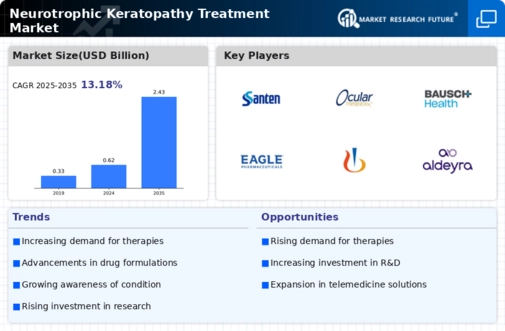Advancements in Treatment Modalities
Innovations in treatment modalities are significantly influencing the Neurotrophic Keratopathy Treatment Market. Recent advancements include the development of neuroprotective agents and regenerative therapies that aim to restore corneal sensation and promote healing. For instance, the introduction of topical medications and surgical interventions has shown promising results in clinical trials, enhancing patient outcomes. The market is witnessing a shift towards personalized medicine, where treatments are tailored to individual patient needs. This trend not only improves efficacy but also increases patient compliance, thereby expanding the market. As new therapies emerge, they are likely to capture a larger share of the market, reflecting the dynamic nature of treatment options available.
Growing Awareness and Education Initiatives
The Neurotrophic Keratopathy Treatment Market is experiencing growth due to heightened awareness and education initiatives. Healthcare professionals are increasingly educated about the condition, leading to improved diagnosis and treatment rates. Campaigns aimed at both patients and providers are essential in disseminating information regarding the symptoms and consequences of untreated neurotrophic keratopathy. As awareness increases, more patients are likely to seek medical attention, thereby driving demand for effective treatments. Furthermore, educational programs and workshops are being organized to equip healthcare providers with the necessary skills to manage this condition effectively. This growing emphasis on education is expected to contribute positively to market expansion.
Regulatory Support for Innovative Therapies
Regulatory support for innovative therapies is playing a pivotal role in shaping the Neurotrophic Keratopathy Treatment Market. Regulatory agencies are increasingly recognizing the need for expedited approval processes for treatments addressing rare and complex conditions like neurotrophic keratopathy. This support facilitates quicker access to new therapies for patients, thereby stimulating market growth. Additionally, initiatives aimed at fostering innovation in the pharmaceutical sector are likely to encourage the development of groundbreaking treatments. As regulatory frameworks evolve to accommodate advancements in medical science, the market is poised for expansion, with a focus on delivering effective solutions to those affected by neurotrophic keratopathy.
Rising Incidence of Neurotrophic Keratopathy
The increasing prevalence of neurotrophic keratopathy is a primary driver for the Neurotrophic Keratopathy Treatment Market. Factors such as diabetes, herpes simplex virus infections, and other corneal diseases contribute to this rise. According to recent data, the incidence of neurotrophic keratopathy is estimated to affect approximately 1 in 1000 individuals, leading to a growing demand for effective treatment options. As awareness of this condition increases, healthcare providers are more likely to diagnose and treat neurotrophic keratopathy, further propelling market growth. The need for specialized therapies to manage this condition is becoming increasingly apparent, indicating a robust market potential for innovative treatment solutions.
Increase in Research and Development Investments
Investment in research and development is a crucial driver for the Neurotrophic Keratopathy Treatment Market. Pharmaceutical companies and research institutions are allocating significant resources to explore new therapeutic options and improve existing treatments. This focus on R&D is likely to yield innovative solutions that address the unmet needs of patients suffering from neurotrophic keratopathy. Recent reports indicate that R&D spending in ophthalmology has seen a substantial increase, reflecting the industry's commitment to advancing treatment options. As new findings emerge from ongoing research, the market is expected to benefit from the introduction of novel therapies that enhance patient care and outcomes.

















Leave a Comment